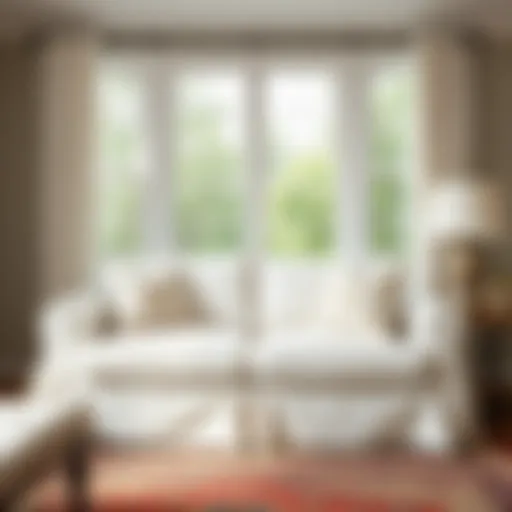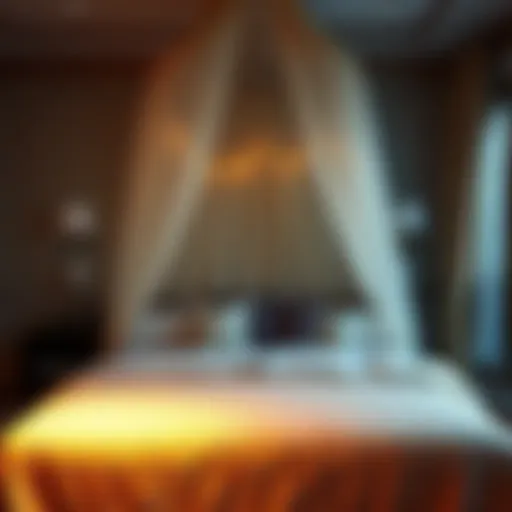Choosing the Best Desktop LED Lamp for Your Workspace
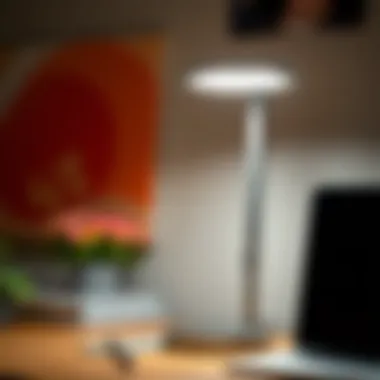
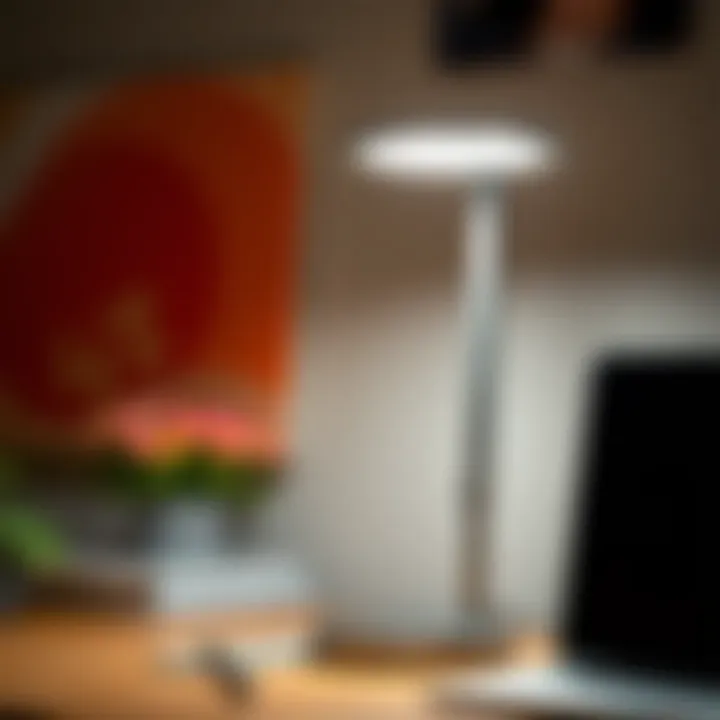
Intro
In today’s fast-paced world, the significance of a well-lit workspace cannot be overstated. A desktop LED lamp serves as not just a tool but an essential companion for productivity and comfort. Whether you're a studious student burning the midnight oil, a busy professional navigating through deadlines, or a DIY enthusiast crafting your next big project, the right lighting can make all the difference.
When thinking about the optimal desk lamp, it’s important to look beyond mere brightness. Factors such as color temperature, adjustable brightness levels, energy efficiency, and design aesthetics play crucial roles in how your workspace feels and functions. Selecting the right lamp isn’t just about illumination but also about enhancing the overall ambiance of your area. This guide will delve into the essentials of choosing a desktop LED lamp that suits your unique needs, examining all angles from functionality to style.
Understanding current trends, exploring popular designs, and incorporating DIY projects will be part of this journey. Let’s illuminate your path to a well-lit workspace.
Furniture Trends
Current Market Trends
As with any home accessory, desktop lamps have evolved, reflecting changing tastes and technological advances. Today's market is full of options, from minimalistic designs that fit perfectly in modern homes, to vintage looks that infuse character into an office setup. There is a clear focus on eco-friendly choices, with many opting for LED lights due to their energy efficiency and longevity.
The rise of remote work has also influenced the trends in workspace lighting. Homeowners are now investing more in creating inviting spaces that stimulate creativity and productivity. Adjustable lamp heights, multi-functional features, and built-in USB ports are gaining popularity as they add convenience and versatility.
Popular Styles and Designs
Venturing into the realm of popular lamp styles, you might encounter:
- Minimalist Designs: Sleek and unobtrusive, these lamps often feature clean lines and subdued colors that blend seamlessly into any decor.
- Industrial Styles: With a raw and rugged appearance, these lamps often boast metal finishes and exposed bulbs, making them perfect for modern urban spaces.
- Smart Lamps: Equipped with smart technology, these lamps can be controlled via smartphone apps, offering features like scheduled lighting and mood settings.
- Vintage Inspired: Nostalgic designs that harken back to a different era, bringing a charming warmth and character to a workspace.
Selecting a lamp that resonates with your style can greatly enhance your workspace aesthetics.
Whether you’re intrigued by the charm of a vintage piece or drawn toward the sleekness of modern aesthetics, understanding the current trends will help you choose a lamp that not only lights up your desk but also complements your overall design narrative.
DIY Projects
Step-by-Step Guides
When it comes to personalizing your workspace, a DIY project can bring your creativity to life. Let’s explore a simple step-by-step guide to create a custom desktop LED lamp that reflects your personality:
- Gather Materials: You’ll need an LED bulb, lamp base, wire, a switch, and any decorative elements you desire.
- Assemble the Base: Start by securing the LED bulb to the lamp base following the manufacturer’s instructions.
- Wire It Up: Carefully connect the wire from the bulb to the switch and then to the power source.
- Customize: Add design elements like paint, fabric, or decor that resonates with your workspace to personalize your lamp.
- Final Touches: Test the bulb to ensure it works. Make any adjustments necessary before placing it on your desk.
Budget-Friendly Ideas
Creating an appealing workspace doesn’t have to break the bank. Here are some budget-friendly ideas to enhance your desk lamp:
- Repurpose Old Lamps: A fresh coat of paint or a new bulb can breathe life into an old lamp.
- Use Natural Materials: Incorporate wood or stone elements for a rustic touch, often found cheaply at thrift stores or in nature.
- Try DIY Shade Covers: Use fabrics or papers that match your space to create custom lamp shades.
Prologue to Desktop LED Lamps
In today's fast-paced world, the significance of a well-lit workspace cannot be overstated. The right kind of lighting can boost productivity, reduce eye strain, and even impact our moods. Desktop LED lamps have emerged as a go-to solution for home offices, study corners, or professional workspaces. Unlike traditional incandescent bulbs, LED lamps provide a range of benefits—from energy efficiency to customizable lighting options—that make them an ideal choice for a myriad of users. For instance, whether you’re a student burning the midnight oil or a design professional sketching out ideas, having adequate and suitable lighting can make a world of difference.
Definition and Purpose
Desktop LED lamps are lighting devices specifically designed for use on a desk or workstation. They function to provide focused illumination for tasks such as reading, writing, or working on electronic devices. LED stands for Light Emitting Diode, a technology that has revolutionized how we think about lighting. These lamps not only use less energy compared to traditional bulbs but also come with the advantage of longer life spans and reduced heat emission. Their purpose goes beyond just shedding light—it is to create an atmosphere that is conducive to work, learning, or creativity. A well-placed LED lamp can serve as both a functional tool and a design element that enhances your workspace.
Evolution of Lighting Technology
Over the years, lighting technology has undergone significant changes, paralleling the advances in our understanding of how light influences our lives. Remember the days of using those bulky incandescent bulbs? They did their job, but at a cost—both on our electricity bills and in terms of impact on the environment. The introduction of compact fluorescent lamps (CFLs) was a step forward; they were more energy-efficient but still had some downsides, like flickering and a delayed warm-up time.
Then came the rise of LED technology. LEDs aren’t just a gimmick; they represent a seismic shift in how we approach lighting. The benefits are clear:
- Energy Efficiency: LEDs consume significantly less power, which means savings on energy costs.
- Longevity: Most LED lamps have lifespans that outlast other types by thousands of hours.
- Versatility: They come in various colors and brightness levels, allowing users to customize their workspace lighting according to specific needs.
With ongoing advancements, such as smart LED technology that allows users to control brightness and color via apps, the future of desk lighting looks promising. Innovation continues to redefine not just how we light our spaces, but also how we interact with and experience them.
"Lighting is not just about illumination. It's about creating spaces that inspire and motivate."
In summary, understanding desktop LED lamps involves recognizing their role in modern lighting technology. As we explore different types of LED lamps, their features, and their effects on productivity and well-being, it becomes clear that these devices are much more than mere tools—they’re essential partners in today’s work environments.
Types of LED Lamps for Desktops
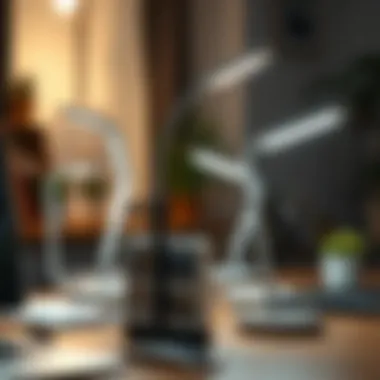
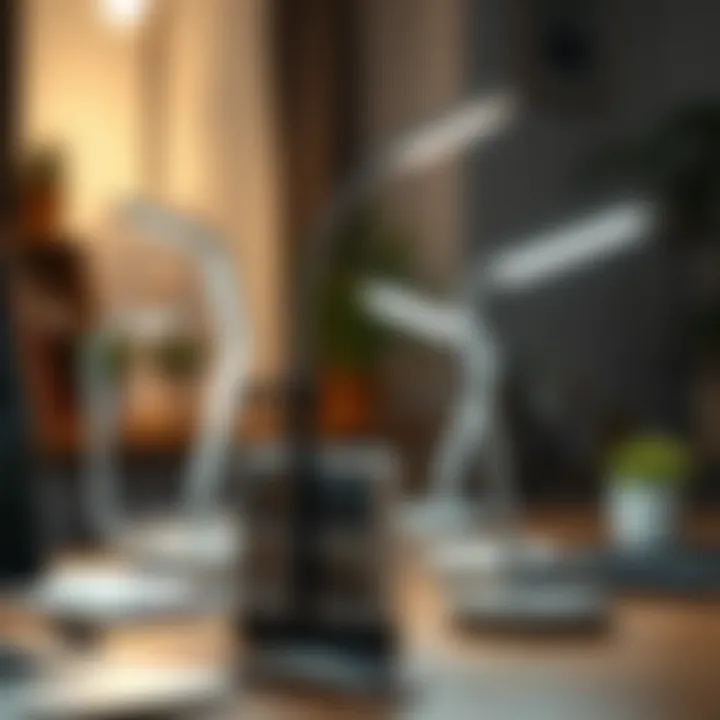
In this guide, we’ll take a closer look at the types of LED lamps suitable for desks, each serving unique purposes and catering to different needs. Selecting the right type is essential not just for illumination, but also for enhancing productivity and creating a comfortable workspace environment.
Task Lighting
Task lighting plays a pivotal role in providing focused brightness directly to your work area. Often used for reading, writing, or intricate tasks such as drafting or assembling components, this type of lighting minimizes shadows and enhances visibility, making it easier to complete detailed work without straining your eyes.
One key consideration is the flexibility of a task lamp. Lamps such as those designed by BenQ or OttLite come with adjustable arms, allowing users to direct light precisely where it’s needed. For those who may wear glasses or require specific lighting conditions due to eye sensitivity, lamps offering dimmability or color temperature adjustments can be a game changer. The direct light they provide can significantly reduce eye fatigue, fostering a more efficient workflow.
Accent Lighting
Accent lighting is the secret sauce when it comes to adding flair to your workspace. While its primary role isn’t to provide illumination for tasks, it helps set the mood and enhances the aesthetic appeal of the room. Think of it as the finishing touch that creates an inviting atmosphere.
Sculptural desk lamps, like those from brands such as Artemide, often serve this purpose beautifully. These fixtures can be strategically placed to highlight features of your workspace or to complement existing decor, making the area feel more personalized. Adding a soft glow with accent lamps can transform how the space feels without overwhelming brightness, contributing to a balanced workspace ambiance. It’s essential, however, to ensure that accent lighting does not obstruct or increase glare on computer screens, as this can create distractions.
Ambient Lighting
Ambient lighting provides a broader, more general illumination that fills the room. Unlike task or accent lighting, ambient light sources, such as LED floor lamps or ceiling fixtures, create a comfortable overall brightness without focusing on specific areas. This type of lighting is crucial for creating a laid-back environment, especially in a home office where comfort is a priority.
For a successful ambient light setup, consider incorporating dimmable LED lamps, such as those offered by Philips Hue. This allows for adjusting brightness levels based on the time of day or the nature of the task at hand. It also opens up possibilities for adjusting the lighting to align with your mood or energy levels. Optimizing an environment with ambient touch can enhance cognitive performance, making it easier to switch from focused work to relaxation in the same space.
Choosing the right type of LED lamp for your desktop can significantly affect how efficiently and comfortably you work. Understanding your needs for task lighting, accent lighting, and ambient lighting will help you create a harmonious workspace, poised for productivity and style.
Key Features to Consider
When it comes to selecting the right desktop LED lamp, understanding the key features is crucial. These elements not only contribute to how well a lamp illuminates your workspace but also affect your mood, comfort, and productivity. Each feature presents its own advantages and considerations that make a significant impact on daily activities. Let's explore these key features one by one.
Brightness and Adjustability
Brightness plays a pivotal role in defining how effectively a lamp serves its purpose. An optimal lamp offers adjustable brightness levels, which allow users to tailor lighting according to their preferences and tasks. For instance, when you’re diving into a deep work session, a brighter setting can enhance your focus, while softer light can create a calming atmosphere for relaxing with a book.
- Lumens: The brighter the light, the higher the lumens. A lamp should ideally provide anywhere from 400 to 800 lumens for most desktop activities. Consider a lamp with a dimming feature, letting you reduce brightness to suit your mood or time of day.
- Adjustability: Some lamps come with innovative features such as touch-sensitive controls or remote adjustments that grant users the ability to shift brightness without much fuss. This makes finding the perfect lighting at a moment's notice easily achievable.
Like they say, “you can’t make a silk purse from a sow's ear.” What’s the use of a stylish lamp if it doesn't light your space adequately?
Color Temperature Range
Another fundamental aspect to take into account is the color temperature range of the LED lamp, which is measured in Kelvins (K). This range influences not just visibility, but the overall atmosphere of your workspace. Color temperature can be categorized into three types: warm, neutral, and cool.
- Warm Light (2000K - 3000K): Often favored for relaxation and coziness, warm light resembles natural sunlight during the early morning or late evening. It’s ideal for casual settings, like a home office.
- Neutral Light (3100K - 4500K): This range strikes a balance between warmth and coolness, which tends to be suitable for general tasks. It's often used in multipurpose spaces.
- Cool Light (4600K - 6500K): On the higher end of the spectrum, cool light mimics daylight and is great for tasks that require precise vision, such as reading or working on intricate projects.
The right color temperature can significantly influence your energy and creativity levels. If you're in a creative profession, you might find cool light helps spark those ideas, while warm light is perfect for winding down in the evening.
Design and Aesthetics
The design of a desk lamp isn't just about function; it's also about how well it fits into your space. A lamp's aesthetics can say a lot about your personal style, complementing your décor or serving as a statement piece.
- Style: Whether it's a minimalist Scandinavian design, a funky retro look, or a sleek modern style, choose something that resonates with your taste. Opt for something that will make you smile every time you glance at it.
- Material: Building materials matter too. Metal lamps can give off an industrial vibe, while wood can add warmth. There are even eco-friendly options that utilize sustainable materials.
- Size: Don't forget about dimensions. You want a lamp that fits your workspace without overwhelming it. A bigger lamp can bring drama, while a compact one can offer subtle elegance.
In the world of lighting, the right design can complete the look of your workspace while maintaining practicality.
Energy Efficiency
As conversations around sustainability continue to grow, energy efficiency has become a vital factor for many homeowners, renters, and businesses alike. LED lamps shine in this area, consuming less energy than traditional incandescent bulbs without sacrificing brightness or quality.
- Energy Star Rating: Look for lamps that are Energy Star certified. These products meet stringent efficiency standards set by the EPA, ensuring you're making an environmentally friendly choice.
- Long Lifespan: Quality LED lamps can last up to 25,000 hours or more, which means less waste and fewer replacements. This longevity translates into not only reduced environmental impact but also savings on your electricity bill.
By choosing energy-efficient lamps, you are contributing to a greener planet while also saving money in the long run.
Understanding Lighting Effects
In the realm of desktop LED lamps, understanding the effects of lighting goes beyond mere aesthetics; it plays a critical role in our daily experiences and productivity levels. The way we perceive and interact with different lighting can significantly influence our physical and mental states. Whether you’re burning the midnight oil on a work project, studying for exams, or just casually browsing the web, the lighting setup should not be an afterthought. Instead, it should be an integral part of creating a functional and inviting workspace.
Impact on Productivity
Lighting acts as the backbone of every productive workspace. A well-lit area can enhance focus and efficiency while minimizing eye strain. Here are some specific elements to consider regarding how lighting affects productivity:
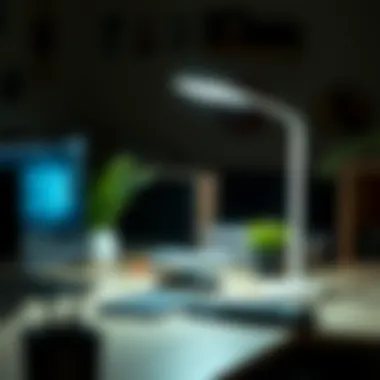

- Brightness Levels: Adequate lighting levels help improve concentration. Insufficient light may lead to fatigue or headaches, while excessive bright lights can be distracting. Studies suggest that adjustable brightness allows for better control over how you want to engage with your tasks.
- Color Temperature: This can tilt productivity in various directions. Cooler lights (under 4000K) can help in tasks that require high focus, while warmer lights (above 3000K) create a more relaxed environment suitable for creative undertakings.
- Task-Specific Lighting: Having the right type of lamp can draw the line between success and frustration. For tasks like reading or drawing, more focused task lighting is paramount. A desk lamp with the ability to articulate can better serve specific needs depending on the chore at hand.
Moreover, research shows that the ideal workspace combines multiple types of lighting—incorporating ambient, task, and accent to create a balanced effect that encourages productivity without compromising comfort.
Influence on Mood and Well-being
Lighting does more than just help us see; it interacts dynamically with our mood and overall well-being. The effects of lighting can intertwine with our emotional responses, influencing how we feel throughout the workday.
- Mood Enhancement: Adequate and strategically placed lighting can create a sense of harmony and warmth in workspaces. Natural light, or lighting that mimics it, is particularly known to boost enthusiasm and general mood. Conversely, dim or harsh lighting can leave one feeling drained or irritable.
- Circadian Rhythms: The body has its own internal clock, synchronized with natural light patterns. Proper illumination can support these natural cycles, aiding in productivity during daylight hours while transitioning to softer lighting in the evening to promote relaxation. For example, blue light in the morning can increase alertness, while softer, warmer lighting in the evening can signal the body it’s time to wind down.
- Visual Comfort: A well-lit environment reduces eye strain, which is vital for mental well-being. Prolonged exposure to poor lighting conditions can lead to headaches and decreased focus, impacting overall job satisfaction and productivity.
In summary, when selecting a desktop LED lamp, understanding the effects of lighting on productivity and mood should guide your choices. As you create your workspace, be aware of how the right lighting can significantly enhance not only the practicality of your environment but also your mental and emotional state, setting the stage for success in your endeavors.
Setting Up Your Workspace
Creating an efficient workspace is more than just plopping down a desk and chair; it’s about curating an environment that fosters productivity and comfort. The role of lighting within this setup cannot be overstated. Properly positioning your LED lamp is crucial, as it directly influences your ability to focus and feel at ease. In this section, we delve into two main aspects of workspace lighting: Optimal Lamp Placement and Coordinating with Other Lighting Sources.
Optimal Lamp Placement
Selecting the right spot for your lamp involves a careful balance between functionality and aesthetics. Here are some considerations to keep in mind:
- Functionality: The primary aim of task lighting is to illuminate your work area. Place the lamp such that it lights directly on your workspace without creating glare on screens or documents.
- Height and Adjustability: A lamp that offers height adjustment or an articulated arm provides flexibility. You can reposition the light as needed, which is handy for varied tasks.
- Avoid Shadows: Position your lamp away from light sources behind you. This reduces shadows on your work surface, making it easier to see fine details without squinting.
- Distance from Walls: Keeping the lamp a few inches from the wall prevents wasted light and ensures more dramatic illumination of the desk area.
By giving thought to these elements, you can transform your workspace lighting from inadequate to impeccable, enhancing overall efficiency.
Coordinating with Other Lighting Sources
To create a well-rounded lighting experience, it’s important to harmonize your LED lamp with existing light sources. Here’s how:
- Layered Lighting: Combine ambient lighting with task-specific sources. For instance, use overhead lights along with your desk lamp. This dual approach prevents eye strain while allowing you to adjust light levels according to your needs.
- Color Temperature Matching: Ensure that your lamp's color temperature complements that of other lights. For example, if your overheads emit a warm glow, go for a similar hue in your desk lamp. This seamless transition makes the space feel cohesive and inviting.
- Dimming Options: If possible, integrate dimmable solutions. Dimming the overall lighting during different times of the day mimics natural light conditions, which can greatly influence your mood and focus.
Setting up your workspace isn’t a one-size-fits-all endeavor; it requires a bit of trial and error. Embracing these tips will guide you through designing a focused and flexible environment that adjusts to your unique work style. Choosing the right placement and coordinating with other lights can make all the difference. Remember, your workspace is where you deliberate, create, and innovate; giving it the proper care can pay dividends in productivity and comfort.
Maintenance of LED Lamps
Maintaining LED lamps is not just a trivial chore; it's a critical element that can dictate the lamp’s performance and lifespan. Ensuring that your LED lamp remains clean and functional can mean the difference between mediocre lighting and a seamless workspace experience. Dust and grime can compromise illumination, while taking care of your lamp can prolong its usability, making it efficiently last longer.
Cleaning and Care Tips
Keeping your LED lamp spick and span involves a few simple yet effective practices. A clean lamp not only looks better but also performs better. Here are some tips:
- Routine Dusting: Use a microfiber cloth to periodically wipe down the lamp without interrupting it. This prevents dust from building up and keeps the light shining bright.
- Avoid Harsh Chemicals: When cleaning, steer clear of strong solvents or chemicals. Simple water with a drop of dish soap is usually all it takes.
- Check the Fixture and Bulb: Regularly inspect the area where the bulb fits into the lamp. Sometimes dust accumulates in the fixture that could impact how well the light bulb sits.
- Unplug Before Cleaning: Safety first. Always unplug the lamp before performing any cleaning to avoid unwanted electrical shocks or damage.
These steps may sound basic, but they can significantly lengthen your lamp's operational life. Keeping things tidy translates to not only a brighter workspace but also smoother overall functionality of your lighting setup.
Longevity and Replacement
Like any piece of equipment, LED lamps have a defined lifespan, but with proper care, their longevity can be extended. Here’s what to consider regarding replacements and the lifespan of LED lamps:
- Understanding Lifespan: Most LED bulbs tout lifespans of about 15,000 to 50,000 hours, depending on usage conditions. This factor differs based on how often you use your lamp and the environment it’s in. Using your lamp for long hours each day might push it nearing the end of its life more quickly than you’d expect.
- Signs of a Dimming Light: If your lamp starts to flicker or the light seems duller, it might be time to replace the bulb. Sometimes these issues can also result from poor connections, so checking the socket and wiring is advisable.
- Energy Efficiency: Even as LED bulbs age, they may still work but will become inefficient. A bulb that once provided quality lighting might increase energy consumption while decreasing output. Replacing it could save on your electricity bill.
- Responsible Disposal: When replacing LED bulbs, consider eco-friendly disposal methods. Many places have recycling programs for old bulbs, which helps minimize environmental impact.
Proper maintenance leads to significant savings in both time and money over the long haul.
Taking good care of your LED lamp is an investment in comfort, environmental stewardship, and financial prudence. It all ties together, and by being mindful about maintenance, you’re also ensuring a fruitful lighting experience in your workspace. Remember that a well-maintained lamp is a happy lamp.
Top Picks for Desktop LED Lamps
Choosing the right desktop LED lamp can feel like finding a needle in a haystack. With myriad options flooding the market, it's crucial to make informed decisions based on functionality, design, and personal needs. This section aims to spotlight top picks across various categories, ensuring that every user—be it a student burning the midnight oil or a professional in need of focused light—can find their ideal match.
Budget-Friendly Options
When it comes to budget-friendly choices, practicality meets efficiency. Often, these lamps do not skimp on quality while keeping costs low. Here's a closer look at what makes these options appealing:
- Affordability: These lamps typically cost less than their premium counterparts, making them accessible for a wider audience.
- Value for Money: Many budget options provide decent brightness, color temperature, and durability without a hefty price tag.
- Features: Look for models that include adjustable brightness and color settings. These features greatly enhance user experience without breaking the bank.
A few standout brands in this category include:


- TaoTronics: Known for their adjustable settings and sleek designs.
- BenQ: Offers good quality lamps at a fair price, ideal for students and casual users.
Premium Selections
For those who are willing to invest in superior lighting, premium selections bring a wealth of features and sophisticated design. Here's what to expect:
- Quality Materials: Premium lamps often use higher-quality materials, ensuring longevity and better light distribution.
- Advanced Features: Models in this category may include smart technology, such as voice control, app connectivity, or customizable lighting profiles.
- Aesthetics: They not only illuminate but also act as stylish decor pieces. A well-chosen lamp can elevate the overall look of a workspace.
Popular picks here include:
- Philips Hue: Renowned for its smart features and seamless integration with home automation.
- Dymaxion: Offers a unique, artistic design that can double as a statement piece.
Innovative Designs
In a world where design can be just as critical as function, innovative designs take center stage. This category is for those who wish to make bold statements with their lighting:
- Creative Functionality: Many innovative designs focus on unique shapes or form factors, transforming traditional lamps into works of art.
- Sustainability: Some options prioritize eco-friendly materials and energy-efficient technologies, appealing to the environmentally conscious.
- Versatility: These designs can often serve multiple purposes, such as establishing ambient lighting while also acting as a nightstand, or adjustable positions to adapt to user needs.
Examples include:
- Mi LED Desk Lamp: Features a minimalist aesthetic along with multiple color modes.
- Lumiy Lightblade: Combines sleek design with technology that allows for precise control of brightness and shade.
Proper lighting can radically transform a workspace, influencing not just mood but productivity itself. Each selection featured here caters to differing needs while ensuring quality and style remain at the forefront.
In sum, whether you're leaning towards budget-friendly selections, premium investments, or cutting-edge designs, there is always a desktop LED lamp that perfectly fits your criteria. Choices abound, but considered choices can better enhance your workspace.
The Future of LED Lighting
In the evolving world of illumination, LED technology stands at the forefront. Understanding the future direction of LED lighting is not just an academic endeavor; it directly impacts how we interact with our spaces and the environment. With growing trends in minimalism and energy conservation, LED lamps are becoming essential in modern design and functionality, shaping how we approach workspace lighting.
Advancements in Technology
The rapid pace of technological advancement continues to transform LED lighting. Recent innovations include tunable white light, which allows users to adjust the brightness and color temperature based on their task or mood. This feature caters to different needs, creating warm lighting for relaxation or bright, cool light for focus. There's also an increasing integration of smart technology, allowing users to control their lamps remotely, via apps or voice commands. Such advancements foster a personalized experience, optimizing productivity.
Additionally, we're seeing improvements in light quality. Newer models produce a broad spectrum of colors, enhancing visuals significantly. Some lamps even mimic natural daylight, reducing eye strain during long hours of work. These innovations not only meet aesthetic values but also focus on enhancing well-being.
Another key development is the trend towards miniaturization. Compact, unobtrusive lamp designs maintain functionality without sacrificing space. This is ideal for tight home offices or small workspaces, allowing for efficient light use.
Sustainability Considerations
Sustainability plays a pivotal role in the future of LED lighting. Unlike traditional incandescent bulbs, LED lamps offer significantly lower energy consumption, which cuts electricity bills and reduces carbon footprint. Since they last much longer, often exceeding 25,000 hours of usage, users reap the benefits of less frequent replacements, leading to less waste.
However, true sustainability transcends the energy efficiency aspect. Manufacturers are increasingly focusing on sourcing materials responsibly and adopting eco-friendly production processes. The rise of recyclable LED materials shows promise in minimizing hazardous waste created at the end of a product's lifecycle. Such measures not only benefit the environment, they create a ripple effect by initiating conversation among consumers and pushing the market in a greener direction.
Moreover, there is a growing market for second-hand or refurbished LED lamps. This trend provides budget-conscious buyers access to quality lighting at lower prices, while still supporting ecological efforts. By embracing this circular approach, consumers can contribute positively to reducing resource depletion.
"Sustainable lighting is not merely an option; it is a necessity for the future of our environments and societies."
End
The significance of concluding any guide cannot be emphasized enough, particularly when discussing the optimal desktop LED lamp. This article serves not just to inform but to synthesize the myriad elements involved in selecting a suitable lamp for your workspace. The readers, who may range from homeowners and renters to designers and DIY enthusiasts, are left with a clearer understanding of how light affects productivity and well-being.
In this fast-paced world, lighting often gets overlooked. Yet, the right desktop LED lamp can make a tangible difference in how effectively one works. As highlighted throughout the discussion, various factors such as brightness, adjustability, and even color temperature have critical roles to play. They can either elevate one’s workspace or lead to considerable distractions and discomfort.
Furthermore, the aesthetics of a lamp shouldn’t be undervalued. A well-designed lamp can serve as a centerpiece of one’s desk, merging functionality with style. Thus, investing time to choose the right desktop LED lamp is not just about illumination, but about creating an optimal working environment that fosters creativity and focus.
Out of the flood of options available today, it’s essential to recall that one size never fits all. The optimal choice varies depending on individual needs, preferences, and even the overall vibe of the workspace.
"Light is more than mere illumination; it sets the mood and tone for creativity and productivity."
Recap of Key Points
- Types of LED Lamps: Understanding task, accent, and ambient lighting helps tailor choices based on specific needs.
- Essential Features: Brightness, color temperature, and design are pivotal in selecting a lamp that not only meets needs but enhances the workspace atmosphere.
- Impact on Well-being: Lighting has a profound effect on mood, alertness, and overall productivity. Proper lighting can reduce eye strain and improve comfort.
- Maintenance and Longevity: Regular upkeep and knowing when to replace lamps can lead to long-term satisfaction and minimized costs.
- Future Trends: Keeping an eye on advancements in LED technology and sustainable practices will ensure informed decisions that benefit both the consumer and the environment.
Final Thoughts on Selection
In wrapping up, the choice of an LED lamp extends beyond mere functionality. It encapsulates an array of considerations. For those weary of poor lighting that leads to fatigue, the right lamp can offer a breath of fresh air, quite literally.
As discussed, the integration of practical illumination with appealing design creates not just a source of light, but a tool of productivity. When contemplating options, think not just about the light but its broader implications on one’s workspace and overall lifestyle. The engaging dance of light and shadow can inspire creativity like no other.
Remember to keep personal tastes at the forefront when making your selection, and don’t hesitate to dive deeper into research for further insights. Always look for reviews, user experiences, and any cutting-edge features that can enhance your selection.











